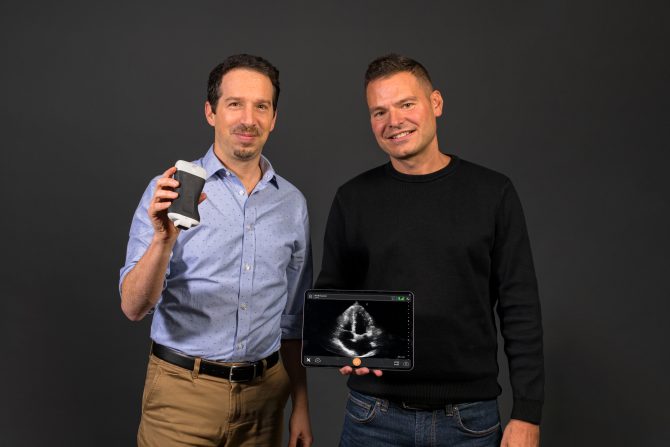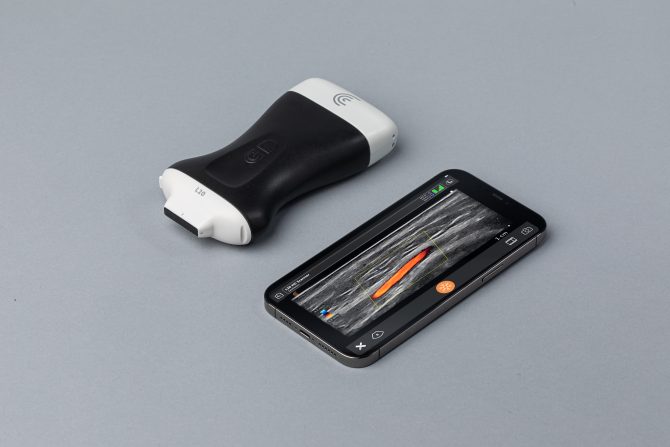
Clarius uses AI to provide better health outcomes
By Sohail Kamal, West Coast Correspondent
Automation / Robotics Electronics Engineering Medical AI Editor Pick medicalB.C. firm creates handheld ultrasound devices
Safer, better medical imaging tools that improve patient care in every setting. That is what Clarius Mobile Health is offering with its 10 AI-powered wireless scanners and advanced cloud-connected ‘Software-as-a Service’ packages designed to optimize imaging across medical specialties and applications. Physiotherapists and medical practitioners can now make an instant, accurate diagnosis with and visualize where exactly to land their needle when injecting localized medications, and they can do so without needing to cart around bulky machinery into treatment rooms.
West Tech Report had the opportunity to chat with Ohad Arazi, president and CEO of Clarius, together with Laurent Pelissier, Clarius founder and chief innovation officer to learn more about the impact they seek to make on healthcare, by delivering affordable ultrasound to medical specialties. The pair are applying AI technology to improve these offerings – now and in the future.
Diagnostic tests at specialty clinics
Imagine a future where instead of making a referral for diagnostic tests at specialty clinics, your clinician performs a real-time ultrasound scan on-site on that same visit and, perhaps even performs the procedure safely under ultrasound imagery guidance. According to Clarius, that future is now. For example, a physiotherapist can use a Clarius L15 HD3 to scan your Achilles tendon to see with certainty if it has ruptured, or your general practitioner, using the Clarius C3 HD3, can diagnose your sudden back pain as either gallbladder disease or kidney stones.

Ohad Arazi, president & CEO (left) with Laurent Pelissier, founder and chief innovation officer of Clarius Mobile Health in Vancouver. Source: Clarius
Since 2015, Clarius has grown from a small start-up with a big idea, to gaining the third largest market share among handheld ultrasound sales in the Americas and Europe.
“Our high-definition wireless scanners are designed for any medical clinician who needs to see under their patients’ skin to accurately diagnose medical issues and to guide safe, precise treatment,” explains Arazi. “Currently, Clarius is most popular with clinicians who deal with musculoskeletal issues such as orthopedic surgeons, sports medicine physicians, physiotherapists and naturopaths, plastic surgeons and aesthetic clinicians, emergency medicine physicians and veterinarians.”
Pioneered a PC-based ultrasound system
The firm has even worked out a deal with the Vancouver Aquarium so that their veterinary staff can use Clarius devices to look after sea lions and other aquatic creatures.
With decades of experience in medical imaging, Clarius has unlocked the power of the radiology department with a line of 10 wireless ultrasound scanners that are little bigger than an iPhone. Pelissier pioneered a PC-based ultrasound system in the 1990s as part of Ultrasonix, which he sold prior to starting Clarius with the goal to further miniaturize ultrasound systems. Much has changed in the industry, and Clarius has been on the forefront of that change. Clarius released its third-generation family of ultrasound scanners this year.

L20 HD3 – an ultra-high frequency ultrasound in a handheld scanner. The only handheld ultrasound with ultra-high frequency to 20 MHz. Wireless and affordable, it delivers exceptional superficial imaging for aesthetics. Source: Clarius
“When we released our first product in 2016, it was considered revolutionary,” observes Pelissier. “Physicians likened it to the Star Trek Medical Tricorder. But, it had its limitations. Like the very first mobile phone, our first-generation wireless scanner was large and too big for smaller hands to hold,” he says.
Process steeped in inefficiencies
Today, Clarius HD3 delivers best-in-class portable ultrasound for your specialty, with an easy-to-use app powered by artificial intelligence and connected to the cloud. At the heart of Clarius hardware lies a cutting edge ‘system[KD1]-on-a-chip’ that supports the system’s Octal Beamforming technology, enabling the wireless scanners to deliver up to eight times the processing power and image resolution of other handhelds. The team has worked hard to help practitioners provide early diagnosis for many medical conditions, from urgent heart conditions to the progress of a pregnancy.
“Other products feel like toys in comparison. Our handheld image quality is uniquely comparable to the big ultrasound machines in hospitals. Clarius is helping redefine patient engagement and fostering trust by making medical imaging more accessible,” says Arazi.
It’s well-known that early diagnosis and interventions improve prognosis. In standard medical clinics, time is lost navigating an inefficient multi-staged process steeped in inefficiencies. Backlogs at imaging clinics, scarcity of expensive ultrasound machines, especially at remote locations, waste time that can be avoided if healthcare providers could have instant access to medical imaging. Clarius is enabling and accelerating this modernization process.
“We are fortunate to be able to work with BC-based institutions who share our mission to spread the use of point-of-care ultrasound machine,” Arazi explains.
AI is used to automatically optimize image quality
Clarius is laser-focused on broadening the delivery of this AI technology to diverse fields and applications. “Clarius is the first ultrasound scanner to use artificial intelligence to automatically detect anatomy at the macro level, allowing physicians to scan without having to adjust the system. AI is also used to automatically optimize image quality on every scanner, eliminating the need to master complex knobs and buttons,” Arazi continues.
Moving forward, the group is keen, using AI, to help practitioners aim at, or detect the appropriate anatomy and optimize the view of the image that needs to be scanned. The Clarius software enables easy archival and retrieval of images both on the Android and the Apple platforms. The firm’s software is also connected to the Cloud to facilitate data transfer and accessibility.
Exciting times ahead for both patients and practitioners, and for the engineers doing magic in the background.
——————
Sohail Kamal is EP&T’s West Coast correspondent.
